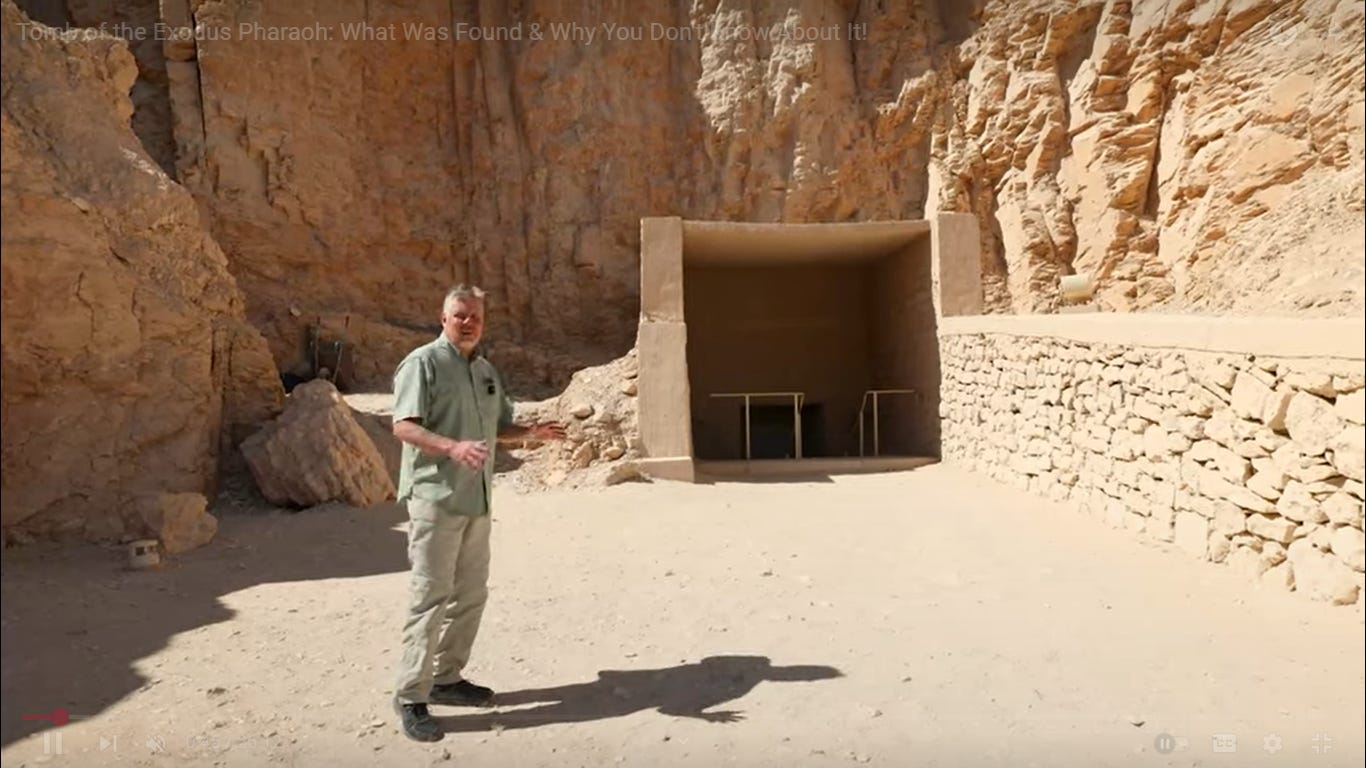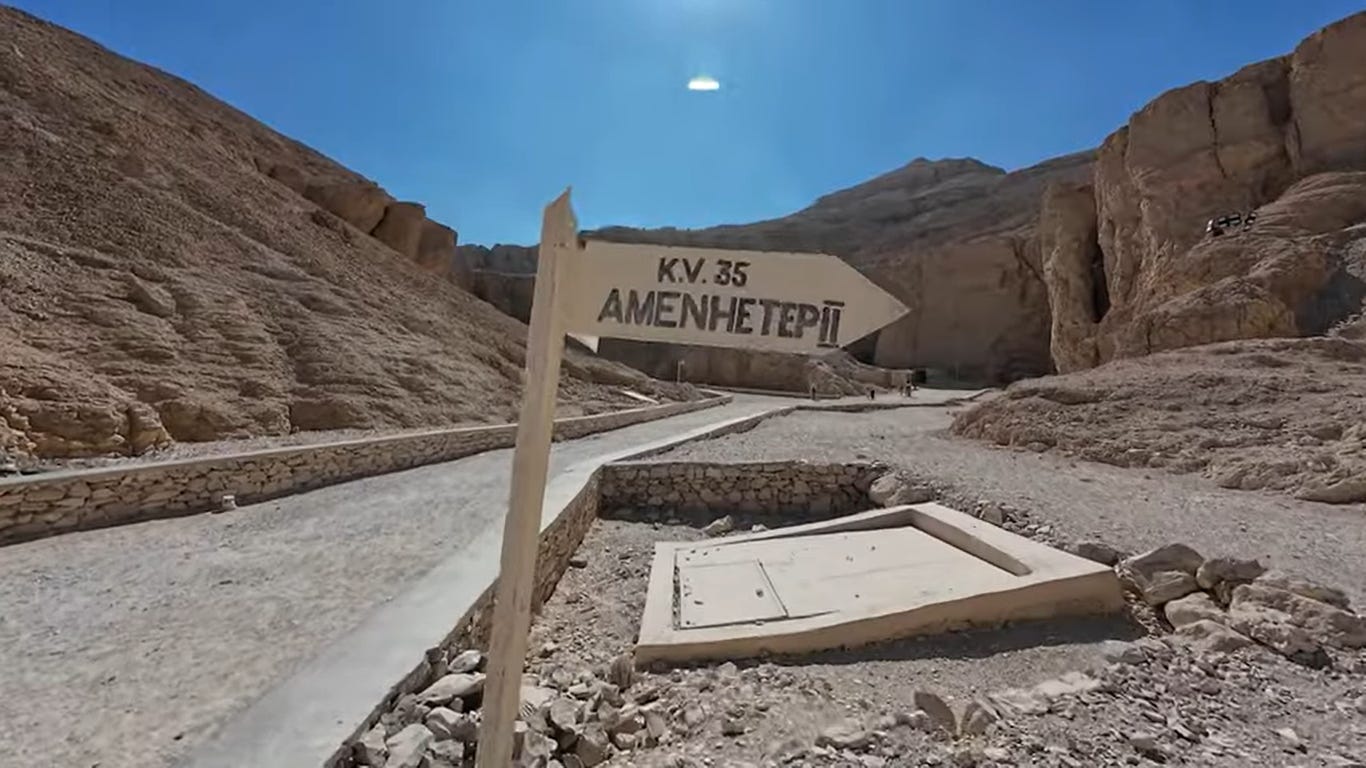I’ve previously written other posts on the Exodus in another one of my Substacks: MOSES & JOSHUA; ISRAELITE EXODUS; THE EXODUS COMET. I also wrote DEAD SEA AIRBURST; and BIBLICAL JACOB & JOSEPH. I provide below images followed by the latter part of the transcript for this recent video:
Archeologist, Joel Kramer.
From his home in Jordan to Luxor, Egypt.
To site of Pharaoh’s Son’s mummy.
Amenhotep II Sarcophagus
Pharaoh’s son, 15 y.o.? Looks way smaller than a 15 y.o. He went on to say the boy was between 15 and 11, but the size looks more like a 7, 8 or 9 y.o.
The boy’s head was shaved, except for a sidelock, common for royalty of that time.
In this initial drawing of the mummies when first found, the boy does look closer to 15 y.o.
Amenhotep II with boils.
{TRANSCRIPT}
Exodus 12 says the Lord struck down all the firstborn in Egypt, including the firstborn of Pharaoh who sat on the throne. So, we know from the biblical account that The Exodus Pharaoh's firstborn died before he did. We know from what was found in the tomb of Amenhotep II that he had a son Webensenu, who died before he did, because he was buried in his tomb. Once a king dies, then he's buried in his tomb with his belongings and his treasures, and that tomb is sealed off—nobody is buried afterwards. So, we know for certain that Webensenu died before his father, because he's buried in his tomb. This is an incredible match, and most probably this is the oldest son of Amenhotep II and therefore the one who would have died in the plague of the firstborn.
Exodus 9:10 says, "So they took soot from a furnace and stood before Pharaoh. Moses tossed it into the air, and festering boils broke out on people and animals." When Smith examined the body of Amenhotep II, these, as he called them, "tubercles," were all over his skin. In fact, you can see this when you go to the Egyptian Museum and see the mummy of Amenhotep II. To this day, you'll see these boil-like sores on his skin. I don't want to make too much of this—we don't know anything for sure—but I also don't want to make too little of it either. Isn't it interesting that if Amenhotep II is The Exodus Pharaoh and is the one Moses stood before when he threw the soot into the air and boils broke out, that he's the one that lived through that plague? Amenhotep II is, of all the kings whose mummies have been found, the one with boil-like sores all over his body.
So, when I did a video in the past on the Pharaoh of The Exodus, one of the major complaints was that we shouldn't have a mummy of the Pharaoh of The Exodus, because he drowned in the sea crossing, and therefore his body would have been lost. There are two reasons from the Bible itself that we should expect to have the mummy of the Pharaoh of The Exodus. The first, which is the most important, is that the biblical account does not say that the Pharaoh of The Exodus drowned in the sea crossing. Exodus 14:23 says that the Egyptians pursued and went in after them into the midst of the sea. This included all Pharaoh's horses, his chariots, and his horsemen. But it doesn't say Pharaoh himself went into the sea. Exodus 14:28 says the waters returned and covered the chariots and the horsemen of all the hosts of Pharaoh, and it specifically says those that followed them into the sea—not one remained. This is typical of how it works with kings: Kings send their armies into battle. Maybe their armies are defeated, but they themselves are not in the midst, fighting the battle themselves—their lives are too valuable for that. Similarly, Psalm 136:15 doesn't say the miracle killed Pharaoh but rather "overthrew Pharaoh." It doesn't say that Pharaoh drowned in the sea crossing. In fact, it implies that he did not.
Even if Pharaoh did die in the sea crossing, we still would expect to have his mummy, because it says in Exodus 14:30 that Israel saw the Egyptians lying dead on the seashore. They saw the bodies of those who had drowned, and from the Egyptian perspective, the most important body to recover would have been the body of Pharaoh. So, either way you look at it, you would expect to have a mummy of the Pharaoh of The Exodus.
We have to talk at least briefly about the biblical date of The Exodus. I'm just going to do this real quick and then move on. First Kings 6:1 says that from The Exodus to the time when Solomon built the temple in Jerusalem, there were 480 years. We know when Solomon built the temple—966 BC. How do we know that? Well, I did a whole video on that using that as an example, and you can watch that after you get done watching this one. But we know that that was 966 BC. You just do the simple math with the 480 years, and we have a solid date for The Exodus from the Bible, which is 1446 BC.
Now, Egyptian chronology is not as well understood and is not agreed upon, even by secular Egyptologists. Some follow what is called the high chronology; some follow the low chronology. The dates of the reign of Amenhotep II and the biblical date fit very well with the high chronology. But regardless, there's an understanding that the dates when these kings reigned are known within about 50 years—you could add 50 years or subtract 50 years. The point I want to make before moving on is simply this: If we take the biblical date for The Exodus, whether we follow the high chronology or the low chronology, whether we add 50 years or subtract 50 years, we're still looking for The Exodus Pharaoh in the 18th Dynasty of Egypt. The 17th Dynasty is way too early; the 19th Dynasty is over 200 years too late. So, The Exodus Pharaoh is somewhere in the 18th Dynasty.
We have here in these discoveries what Laray calls in his report this "strange chronological series" because they followed the lineage of the royal family of the 18th Dynasty. Before he found the tomb of Amenhotep II, previously in that same excavation season, he had discovered and excavated the tomb of Thutmose III, the father of Amenhotep II. What is unique about Thutmose III is the length of his reign—he reigned for 54 years. Exodus 2 says that Pharaoh tried to kill Moses, but Moses fled from Pharaoh to Midian. During that long period, the king of Egypt died, finally allowing Moses to return to Egypt. This long period when Moses was in Midian, we are told in Acts 7:30, ended after 40 years, and then he comes back. At this point, the next Pharaoh is reigning, and this is the Pharaoh of The Exodus. In order for this to work, we need the predecessor of The Exodus Pharaoh to have a very long reign of over 40 years. The only Pharaoh in the 18th Dynasty that reigned for more than 40 years is Thutmose III—he reigned for 54 years and is the father of Amenhotep II.
Therefore, of all the Pharaohs of the 18th Dynasty, the only Pharaoh that fits this requirement from the Bible is Amenhotep II because his father reigned for over 40 years. How much more obvious could it be? From what Laray found in the tomb of Amenhotep II, he found the mummy of Amenhotep II that had a shroud wrapped around it, which had Amenhotep II's name on it.
He found this mummy that was covered with these boil-like sores. He found the son of Amenhotep II, Webensenu. He found his name inscribed on a funerary statue. He found his name inscribed on a canopic jar. And he found the mummy of a boy with a prince's lock.
I mean, we're talking about why is this not the most famous tomb from the Valley of the Kings? It should be, and yet it's closed and people don't know about it. And then, when you look it up today on the internet or wherever you're doing your research, the more modern takes on this are all arguing against these positions that were well established and understood in the past. They're the ones that the evidence bears witness to, and yet now all these arguments. It's a focus of these arguments: "Oh, 480 years doesn't really mean 480 years." "Oh, the length of this reign isn't really the length of just one Pharaoh's reign but of more than one Pharaoh's reign." "Oh, this mummy that was found in Amenhotep II's tomb isn't really the son of Amenhotep II but this other Pharaoh," and on and on and on.
Why? Why is the focus of all this argument on Amenhotep II? The simple answer to that is it's because Amenhotep II holds the evidence for being the Pharaoh of the Exodus. So, all of the evidence demonstrates that Amenhotep II is the Pharaoh of the Exodus, and his mummy was discovered in his tomb, in his sarcophagus, and in his coffin.
So why does this even matter? It matters because the Exodus event is a real event. The Israelites are real people. The Pharaoh that held them in bondage in slavery was a real Pharaoh, and the God of the Bible is also real, who came and broke the power of Pharaoh to set his people free, so that they could be in relationship with him.
… Also, I'll leave a link up here where you can watch the next video, "How We Know the Dates for the Bible in the Old Testament." Very good supplementary information for what you've learned in this video.

















I live in Austria again. Before in Switzerland and Liechtenstein. Two years in the U.S. but that's long ago. 1995/96 in Carbondale IL (east of you, I guess) and NY, 2000/2001 in New York City.
Hi. My pleasure. I was born in Austria. The ü causes the G to sound more like a K than a u would have. I guess, therefore Kinder (for Gunter). Ginter fell probably flat because of the Prohibition (or the ideas of it).